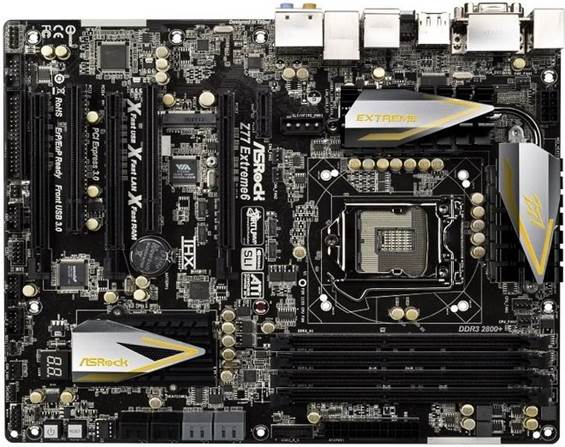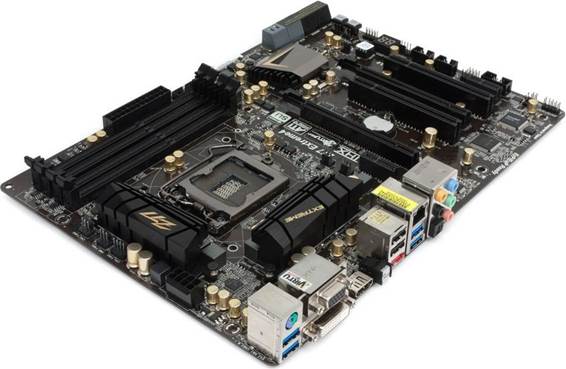Although fourth-gen Intel Core 17 has
arrived, there's still plenty of life left in Sandy Bridge and Ivy Bridge, so
this week we are looking at a group of LGA1155 motherboards.
I’m starting to get wise to the ways of ASRock,
and this Z77 Extreme4 is a very good example of how it produces motherboards.
For starters, there's the initial impression you get when the board comes out
of the package, which is very stylish and rather impressive. The PCB is dark
brown, the expansion slots are black, all of the capacitors are gold in color,
and there are various toys such as the LCD debug display and the power and
reset buttons.
Overall, the impression is of a motherboard
that looks great and oozes luxurious quality In fact, there's a degree of
inconsistency, as the ports and connectors on the I/O panel are color coded for
ease of connection and so too are the three graphics outputs and the USB 3.0,
USB 2.0 and SATA ports.

ASRock
Z77 Extreme4
By contrast, the headers and connectors on
the board are all black, with the notable exception of the SATA connectors
(grey for SATA 6Gbps and black for SATA 3Gbps), and that doesn't really help
when you're delving around inside a PC chassis and you have a covering of dust
on the surfaces.
When you take a closer look, you'll see
that the three heat-sinks on the chipset and power regulation hardware are
secured with plastic pop pins rather than a decent set of screws.
Where ASRock really scores is the list of
features, as it's hard to point to any obvious failings or weak spots. On the
I/O panel there's no FireWire port, but that suits me just fine, because I
haven't used FireWire since I owned a DV camcorder at least five years ago. On
the I/O panel ASRock provides HDMI, DVI-D and VGA outputs for the integrated
graphics. You don't get a DisplayPort output, so ASRock fails to tick that
particular box, but in fairness it can be said that DisplayPort is a niche
interest.
There are four USB 3,0 ports, with a
mid-board header for two more ports, and you also get two USB 2.0 ports with
headers for as many as six more USB ports.

You
don't get a DisplayPort output, so ASRock fails to tick that particular box,
but in fairness it can be said that DisplayPort is a niche interest.
In addition to that solid list of features,
you get those micro buttons and LCD debug display ASRock has included its
system of dual mounting holes, so you can use either an LGA1155/11 56 cooler or
an older LGA775 CPU cooler. The latter option probably only makes sense if you
have an aged and beloved water cooling system,
The specification of the Til Extreme4 is
decent, and there's nothing obvious to complain about.
When I started testing the ASRock I found
the UEFI setup screen addressed the issue of overclocking in two distinct ways.
The first option is the curiously named Advanced Turbo Mode 30, which comes
with no explanation and appears to raise the CPU speed to a preset figure of
4.7GHz, but this was no good, since Windows 7 was flaky and failed to work
reliably.

The
specification of the Til Extreme4 is decent, and there's nothing obvious to
complain about.
The alternative is Load Optimized CPU OC
Setting, which has a list of Turbo Boost options that range from 4GHz to 4.8GHz
in 200MHz steps. I tried the 4.6GHz setting, which should have been safe
enough, but once again Windows refused to behave until I dropped the Turbo
speed to 4.4GHz.
|
Details
·
Price: $153
·
Manufacturer: ASRock
·
Website: www.asrodf.com
Ratings
·
Overall: 8
·
Quality: 9
·
Value: 8
|